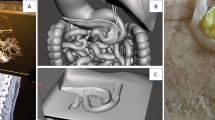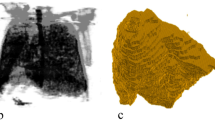Abstract
Purpose
There is a paucity of methods to model soft anatomical tissues. Accurate modelling of these tissues can be difficult with current medical imaging technology.
Methods
The aim of this research was to develop a methodology to model non-intestinal colorectal tissues that are not readily identifiable radiologically to enhance contextual understanding of these tissues and inform medical device design. The models created were used to inform the design of a novel medical device to separate the mesocolon from the retroperitoneum during resection of the colon. We modelled the peritoneum and the mesentery. The mesentery was used to indicate the location of Toldt’s fascia.
Results
We generated a point cloud dataset using cryosection images as the target anatomy is more visible than in CT or MRI images. The thickness of the mesentery could not be accurately determined as point cloud data do not have thickness. A denser point cloud detailing the mesenteric boundaries could be used to address this.
Conclusions
Expert anatomical and surgical insight and point cloud data modelling methods can be used to model soft tissues. This research enhances the overall understanding of the mesentery and Toldt’s fascia in the human specimen which is necessary for medical device innovations for colorectal surgical procedures.






Similar content being viewed by others
Data availability statement
The Visible Human Project datasets analysed during the current study are available in the VHP repository, https://mri.radiology.uiowa.edu/visible_human_datasets.html. The data which were created from the VHP cryosection images such as the point cloud are available from the corresponding author on reasonable request. The resulting outputs of all data analysed during this study are included in this current study. The point cloud data and a 3DPDF of the generated mesentery model accompany this journal paper.
References
Kinugasa Y, Murakami G, Suzuki D, Sugihara K (2007) Histological identification of fascial structures posterolateral to the rectum. Br J Surg 94(5):620–626
Choi HK, Law WL (2015) Total mesorectal excision: from open to laparoscopic approach. In: Minimally invasive coloproctology. Springer, Cham, pp 75–90
Allaix ME, Krane MK, Fichera A (2015) Total colectomy and proctocolectomy: hand-assisted laparoscopic approach. In: Advanced techniques in minimally invasive and robotic colorectal surgery. Springer, Boston, MA, pp 189–197
Pedraza R, Faraj C, Haas EM (2015) Sigmoid colectomy and left hemicolectomy: single-port laparoscopic approach. In: Advanced techniques in minimally invasive and robotic colorectal surgery. Springer, Boston, MA, pp 129–142
Coffey JC, Dillon M, Sehgal R, Dockery P, Quondamatteo F, Walsh D, Walsh L (2015) Mesenteric-based surgery exploits gastrointestinal, peritoneal, mesenteric and fascial continuity from duodenojejunal flexure to the anorectal junction—a review. Dig Surg 32(4):291–300
Trajanovic M, Vitkovic N, Stojkovic M, Manic M, Arsic S (2009) The morphological approach to geometrical modelling of the distal femur. In: 2nd South-east European conference on computational mechanics, proceedings SE191
Navab N, Glocker B, Kutter O, Kirchhoff SM, Reiser M (2015) Medical image processing for analysis of colon motility. In: Handbook of biomedical imaging. Springer, Boston, MA, pp 391–401
Coffey JC, O’Leary DP (2016) The mesentery: structure, function, and role in disease. Lancet Gastroenterol Hepatol 1(3):238–247
Delaney CP, Lawrence JK, Champagne BJ, Keller DS, Senagore AJ (2013) Operative techniques in laparoscopic colorectal surgery. Lippincott Williams & Wilkins, Philadelphia
Rivas JG, y Gregorio SA, Eastmond MAP, Gómez AT, Ledo JC, Togores LH, de la Peña Barthel JJ (2013) Transperitoneal laparoscopic pyeloplasty in the treatment of ureteropelvic junction obstruction. Pain 39:63
DiZerega G (1999) Use of adhesion prevention barriers in pelvic reconstructive and gynaecoloigical surgery. In: DiZerega GS et al (eds) Peritoneal surgery. Springer, New York, pp 379–399
Rengier F, Mehndiratta A, von Tengg-Kobligk H, Zechmann CM, Unterhinninghofen R, Kauczor H-U, Giesel FL (2010) 3D printing based on imaging data: review of medical applications. Int J Comput Assist Radiol Surg 5(4):335–341
Torres K, Staskiewicz G, Sniezynski M, Drop A, Maciejewski R (2011) Application of rapid prototyping techniques for modelling of anatomical structures in medical training and education. Folia Morphol (Warsz) 70(1):1–4
Bagaria V, Deshpande S, Rasalkar DD, Kuthe A, Paunipagar BK (2011) Use of rapid prototyping and three-dimensional reconstruction modeling in the management of complex fractures. Eur J Radiol 80(3):814–820
Chougule VN, Mulay AV, Ahuja BB (2014) Development of patient specific implants for minimum invasive spine surgeries (MISS) from non-invasive imaging techniques by reverse engineering and additive manufacturing techniques. Procedia Eng 97:212–219
Allen LK, Bhattacharyya S, Wilson TD (2015) Development of an interactive anatomical three-dimensional eye model. Anat Sci Educ 8(3):275–282
Ren B, Jiang Y, Xia HM, Li XY, Tan LW, Li Y, Li QY, Li XS, Gao YH (2013) Three-dimensional digital visible heart model and myocardial pathological characteristics of fetal single ventricle connected with aortic coarctation. Genet Mol Res 12(4):5247–5256
Sanders I, Mu L (2013) A three-dimensional atlas of human tongue muscles. Anat Rec 296(7):1102–1114
Sun D, Rettmann ME, Holmes DR III, Linte C, Cameron B, Liu J, Packer D, Robb RA (2014) Anatomic surface reconstruction from sampled point cloud data and prior models. Stud Health Technol Inf 196:387
Barbeito A, Cabral P, Painho M, O’Neill JG (2014) An integrated model of the human body. In: Proceedings of Portuguese Association for Information Systems (CAPSI) 14th conference on health information systems
Coffey JC, Culligan K, Walsh LG, Sehgal R, Dunne C, McGrath D, Walsh D, Moore M, Staunton M, Scanlon T (2015) An appraisal of the computed axial tomographic appearance of the human mesentery based on mesenteric contiguity from the duodenojejunal flexure to the mesorectal level. Eur Radiol 26:1–8
Ackerman MJ, Spitzer VM, Scherzinger AL, Whitlock DG (1994) The Visible Human data set: an image resource for anatomical visualization. Medinfo. MEDINFO 8:1195–1198
Funding
This study was funded by the Irish Research Council under the IRCSET Scholarship Scheme.
Author information
Authors and Affiliations
Contributions
EW assisted in designing the study, evaluated the modelling techniques, performed the modelling work as presented (Figs. 1, 2, 3, 4, 5, 6), and contributed to each section of the manuscript. MM contributed to the review of the modelling approaches, and to the methods description in the manuscript. MW contributed to the design of the model validation approach, and to the writing of the results section. CC is a surgical and anatomical expert in this topic. He highlighted the need for the modelling of the anatomy, he detailed the relevant anatomy, and he reviewed the models developed. He also contributed to the overall manuscript layout and approach. LW created the point cloud data set and he also reviewed the accuracy of the models developed. He contributed to the method section of the manuscript. DW and EW explored the modelling approaches, and together developed the modelling approach as presented in the manuscript. LO’S designed the study and coordinated the activities and contributions of all authors to the manuscript. He led the point cloud acquisition session. He also led the writing of each section of the manuscript.
Corresponding author
Ethics declarations
Conflict of interest
The authors declare that they have no conflict of interest.
Ethical approval
This article does not contain any studies with human participants or animals performed by any of the authors.
Electronic supplementary material
Below is the link to the electronic supplementary material.
Rights and permissions
About this article
Cite this article
White, E., McMahon, M., Walsh, M. et al. 3D modelling of non-intestinal colorectal anatomy. Int J CARS 14, 73–82 (2019). https://doi.org/10.1007/s11548-018-1863-y
Received:
Accepted:
Published:
Issue Date:
DOI: https://doi.org/10.1007/s11548-018-1863-y




